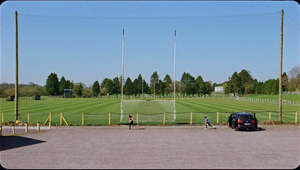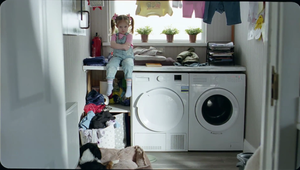
“An Experience... In Space!... But at the Cinema”

We bet that Hugh Loughrey, creative director at GABHA Studios, didn’t think he’d have to ponder the scientific accuracy of black holes at any point in his career. But the day came and he excitedly told us that the black hole the GABHA team created for an opening sequence for the cinema company Omniplex are “technically more scientifically correct than the one in ‘Interstellar’ [as] ours is only bright on one side due to the phenomenon known as ‘gravitational redshift’.” Thanks, Hugh – that’s genuinely good to know!
The team was excited when agency 53Six initially approached them with the concept. The brief was simple and fun: a space-based creative centered around a black hole, to appear in cinemas. Unfortunately the concept was put into cold storage for a number of months and this prompted respective teams to approach the concept in a slightly new way. Using customer quotes based on the research from 53Six, there were clear trends around what motivated cinemagoers to attend the cinema – words like journey, experience, and escape came to the fore. Inspiration soon started to flow and the team turned to iconic space scenes from ‘Interstellar’ and ‘2001: A Space Odyssey’, taking their macro perspectives and transposing them onto a journey through the lens of the projector. Sound was as crucial as the visuals and the team worked with sound designer, James Latimer, pretty much from the start to create a truly immersive soundscape.
It was an ambitious idea and not an easy one to make come to life. The team worked tirelessly to make the opening sequence look as good as the big-budget blockbusters they took their visual cues from while getting to grips with a 3D graphics software, Blender, they hadn’t used before. The visually and aurally arresting result speaks for themselves and Irish cinemagoers will get to experience it before every film.
LBB sat down with Hugh to learn more about the project, how the suggestion of a modular timeline won the client over, and the special feeling of knowing your work will be seen exclusively on a giant screen.
LBB> What kind of brief did you get from Omniplex?
Hugh> The creative had been in development at 53Six for a while but the concept was put into cold storage for a few months, so we collectively reapproached the creative and developed a fresh treatment.
LBB> What were some of your initial thoughts about it?
Hugh> This just seemed like one of those really fun projects that come along all too infrequently. The fact that it was to be played exclusively on the silver screen on a great audio system, the thought of making great space visuals with no product, it just got the whole team kind of giddy and excited.

LBB> Tell us how you landed on the final idea?
Hugh> The guys at 53Six had already done some great work on the project. In their research they came across customer quotes about why they go to the cinema and words like journey, experience, escape really jumped out.
Further, 53Six had developed a creative positioning and tagline of ‘Experience More’, accompanied by some initial boards that focused on a journey through space. The hope was that Omniplex would give viewers an incredible experience in the preshow.
We needed to elevate these boards, go on a journey, and have an experience... in space!... but at the cinema. We started brainstorming iconic cinematic space scenes and figuring out how to put them together within the existing framework. Further, we were aware of some client concerns. One of which was viewer fatigue. I think they had planned to show the spot before every movie in every cinema for like five years.
That's when we came up with the idea of a modular timeline. I think this was the main eureka moment from a client buy-in POV. We pitched the idea of a main hero film, but, within it, we have three distinct sections, using cuts instead of one long continuous shot, essentially giving the client the option of playing any of the three sections individually, or, the whole film in its entirety. Essentially, giving them four or even five spots, a 20", a 30", 45", and 1’20" options for the price of one.

LBB> The whole spot was created using CG: can you run through how you made that happen? What kind of techniques/tech/software did you use?
Hugh> One big eye opener for me was this being the first time working on a project utilising Blender [a 3D computer graphics software tool]. We thought Houdini was going to do the CG heavy lifting but were really blown away at what Blender can do in the hands of a talented artist. Black holes are really, really hard to make (who knew?) and really, really time consuming to render. You can't playblast a black hole, you have to render it fully in order to get a vague idea what the end result will look like. We invested a lot of time using Houdini but it wasn't until we tried using Blender that things really started to come together. The black hole section was really a collaboration between Blender and proper heavy lifting in Nuke. We were really blessed with the level of talent from our artists Sam and Doru.
The other sections were a little more straightforward, but no less complex. Stargate was a combination of Houdini, After Effects and Nuke while the end Planet section was all Houdini and Nuke.

LBB> ‘Interstellar’ is a reference for the project. How did you use it to inspire you – did any other references make their way into the creative discussion?
Hugh> I guess you could say Christopher Nolan's penchant for practical effects was a great excuse to get Chris Parks involved. Chris is a cloud tank specialist and captures stunning organic fluid forms all in 6K and at high frame rates. We made good use of these elements on the shots leading up to the main ‘Interstellar’ Gargantua shot. We felt Chris's elements gave their scenes a more timeless feel and was also a nod to the sci-fi films of the pre-digital era where such elements were used with more regularity.
The stargate from ‘2001: A Space Odyssey’ was another major reference. We thought it would be really cool to repurpose the stargate as an audio showcase section using the Dolby Atmos theatrical sound design to create a really immersive experience as these graphic shapes fly over your head.
LBB> Sound is a huge component here, emphasising visuals and giving sound and weight to movement. When in the process did you bring in the sound designer and how did you work together?
Hugh> Sound was super important so Jim was involved from the start pretty much. We worked remotely sending each other WIPs over Slack which worked well. Sometimes though things can get lost in translation depending on what kind of system you are reviewing audio on. Laptop speakers are a bad idea. However, we are really lucky at GABHA to have an amazing screening room. I remember the guys had just upgraded the subwoofer. One of Jim's later Omniplex WIPs was the first thing we ever played on it. I just remember my jeans deforming under the weight of the bass. The grin on everyone's face afterwards was pretty funny.
LBB> As this is going to play in cinemas – on a big screen and through a great sound system – what kind of considerations did you have in mind while working on it?
Hugh> Nothing really, we just felt really privileged that we were working on something that was going to be exclusively viewed on a big proper screen. Most of the time you work on projects that end up being viewed on a phone, if you're lucky, so this felt special.

LBB> Did you run into any challenges? How did you overcome them?
Hugh> Render times were considerable. This was really a challenge in terms of time we may have over invested in on our look dev. It was also challenging fleshing out the timeline for audio. We had to commit to camera moves earlier than we would have done usually. Collaboration and communication got us to where we needed to be. That, and a lot of late evenings.
I think the main challenge though was that we let our ambition get the better of us. It was only after we got the pitch sign off that the penny really dropped. We now had to go out and re-create three scenes from three VFX Oscar winning $100m budget movies for a titanically smaller budget and in seven weeks. I think we ended up with something that looks pretty epic and something we can be really proud of. Ultimately we overcame our challenges because everyone on the team was invested in the project. Who knew VFX artists enjoyed rendering space stuff so much?
LBB> What’s your favourite part of working on the project?
Hugh> Getting to channel my inner Partridge explaining to a few unfortunates that our black hole was technically more scientifically correct than the one in ‘Interstellar’. Ours is only bright on one side due to the phenomenon known as ‘gravitational redshift’!















